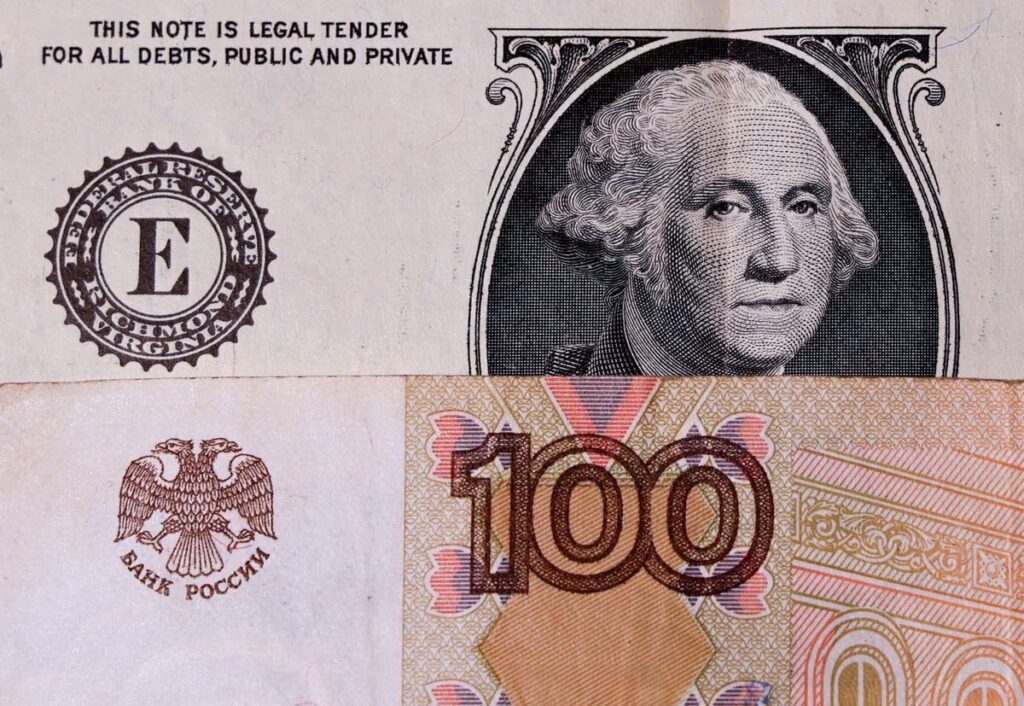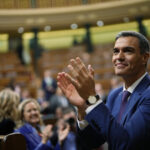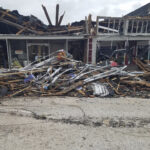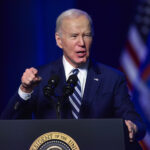The Russian ruble continues to weaken on Tuesday in volatile trade after the central bank hiked rates by 350 basis points to 12%, a move that was baked into market expectations after the bank called an emergency meeting to head off heavy currency losses. The extraordinary rate meeting came after the ruble plummeted past the 100 threshold against the dollar on Monday and the Kremlin criticized the central bank’s monetary policy. The Associated Press has the story:
Russia’s central bank makes huge rate hike over falling ruble
Newslooks- TALLINN, Estonia (AP)
Russia’s central bank made a big interest rate hike Tuesday, an emergency move designed to fight inflation and strengthen the ruble after the country’s currency reached its lowest value since early in the war with Ukraine.
The ruble has lost more than a third of its value since the beginning of the year as Moscow increases military spending and Western sanctions weigh on its income from energy shipments. The flagging currency does not mean the Russian economy is in freefall — though it is facing challenges, including rising prices for households and businesses, according to analysts who study Russia.
A lower exchange rate allows Moscow to transfer the dollars it earns from selling oil and natural gas into more rubles to pay pensions and run government agencies. But the drop in value went a bit too far, and officials are now tightening it up, analysts say.
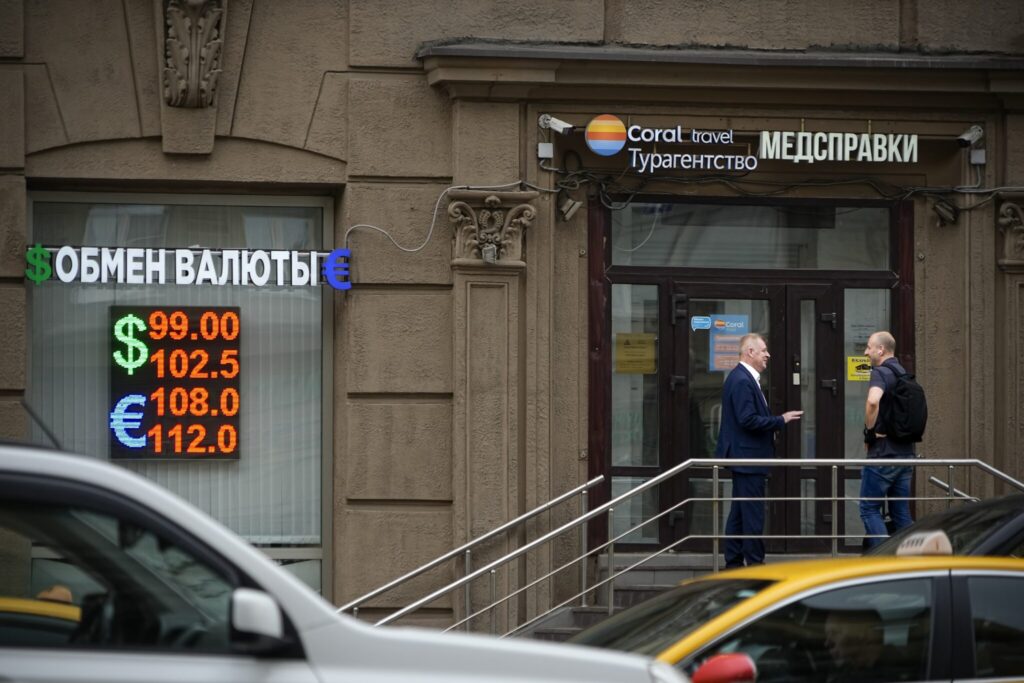
While over time sanctions will erode long-term economic growth, the recently weaker ruble “does not imply an underlying economic crisis, it doesn’t suggest Russia is about to fall off a cliff,” said Chris Weafer, CEO of Macro-Advisory Partners.
The central bank hiked its key rate 3.5 percentage points to 12% after announcing a meeting of its board of directors a day earlier as the ruble declined.
The Russian currency passed 101 rubles to the dollar Monday, hitting the lowest level in almost 17 months. The ruble strengthened after the rate hike announcement but has since given up some of those gains to hit about 98 to the dollar.
The central bank says demand for goods has exceeded the country’s ability to expand output, increasing inflation and affecting “the ruble’s exchange rate dynamics through elevated demand for imports.”
Until now, the ruble’s decline suited the government because it increased the amount of rubles for each dollar of oil revenue, helping the Kremlin maintain spending on the military and social programs, Weafer said. The government and the central bank have been able to manage the ruble’s decline by telling energy exporters when to exchange their dollar earnings. “It is an entirely managed currency,” Weafer said.
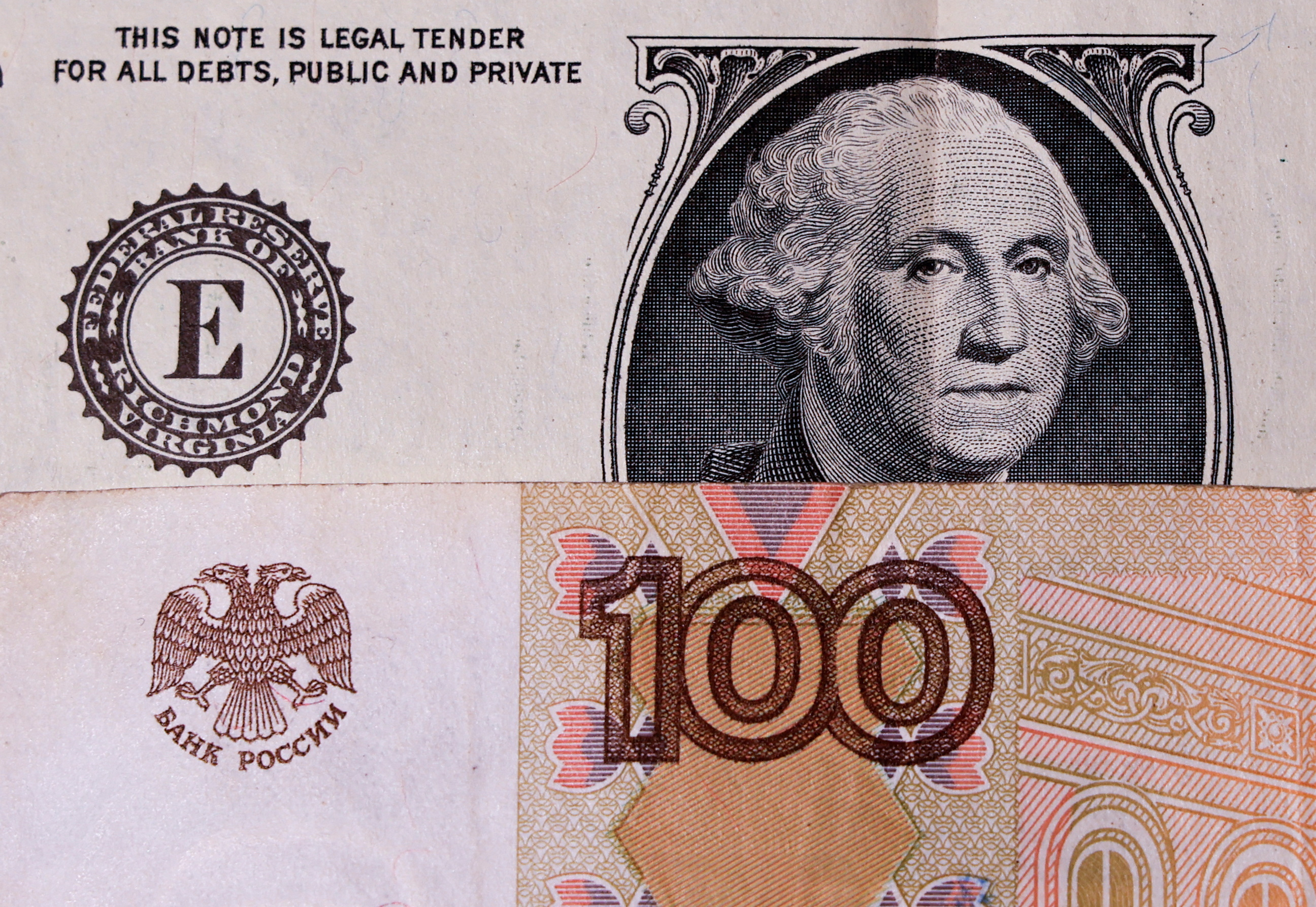
A view shows U.S. one-dollar and Russian 100-rouble banknotes in this illustration picture taken August 14, 2023.
That intentional devaluation now “appears to be overdone. I think this is now the message from the central bank — the weakness was planned, but it’s overdone and they want to pull it back,” he said. Sergei Guriev, provost and professor of economics at the Sciences Po institute of political studies in Paris, also said “there is no disaster” despite Russia’s economy having “big problems” — such as the decrease in oil and gas revenue, capital fleeing the country, a budget deficit and the weaker ruble.
It was “politically important” for the Russian authorities to have the national currency at less than 100 rubles to the dollar, so once the ruble crossed that sensitive threshold this week, the central bank took action, Guriev said.
A weaker ruble benefits the government but also means “higher costs for households and for certain parts of the Russian war machine,” Guriev said.
“If you need to buy (weapon) components in Iran or circumvent sanctions through third countries, you need foreign currency,” Guriev said. “That’s why you have the budget deficit.”
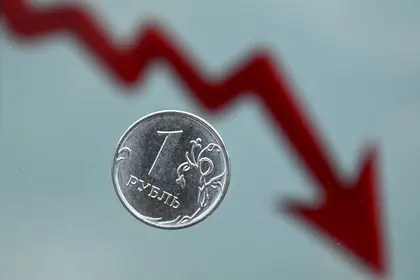
This photograph taken on July 6, 2022 shows a Russian ruble coin in Moscow.
The rate hike came after President Vladimir Putin’s economic adviser, Maksim Oreshkin, on Monday blamed the weak ruble on “loose monetary policy” in an op-ed, saying the central bank has “all the tools necessary” to stabilize the situation and that he expects normalization shortly.
By raising borrowing costs, the central bank is trying to fight price spikes as Russia imports more and exports less, especially oil and natural gas, with defense spending going up and sanctions taking a toll. Importing more and exporting less means a smaller trade surplus, which typically weighs on a country’s currency.
Inflation reached 7.6% over the past three months, the central bank said. It also hiked rates 1 percentage point last month, saying inflation was expected to keep rising and the fall in the ruble is adding to the risk. Its next meeting is planned for Sept. 15.
After Western countries imposed sanctions on Russia over the invasion of Ukraine in February 2022, the ruble plunged as low as 130 to the dollar, but the central bank raised its key interest rate to as high as 20% in the days afterward and enacted capital controls that stabilized the currency’s value. It later began cutting rates.
Russia’s ruble has tumbled. What does it mean for the wartime economy?
Russia’s ruble has fallen a long way in recent months, and the country’s central bank has stepped in to try to halt the slide.
Until now, the government stood aside as the declining ruble helped its budget. But a weaker currency also poses the threat of higher prices for everyday people in Russia — and the government has finally moved to halt the drop.
Here are key things to know about the ruble:
WHY IS THE RUBLE FALLING?
Economic fundamentals play a role, though they aren’t the whole story. Russia is selling less abroad — mainly reflected in falling revenue from oil and natural gas — and it’s importing more. When goods are imported to Russia, people or companies have to sell rubles for foreign currency such as dollars or euros. That tends to lower the ruble’s exchange rate.
Russia’s trade surplus — meaning it sells more goods to other countries than what it buys — has shrunk. Trade surpluses typically support a country’s currency. Previously, Russia saw a large trade surplus because of high oil prices and plummeting imports after Russia invaded Ukraine.
But oil prices have dipped this year, and it’s more cumbersome for Russia to sell its oil due to Western sanctions, including price caps on crude and oil products like diesel.
“Significantly lower inflows of foreign currency due to the drop in exports are the key driver” of the ruble’s decline, according to the Kyiv School of Economics Institute.
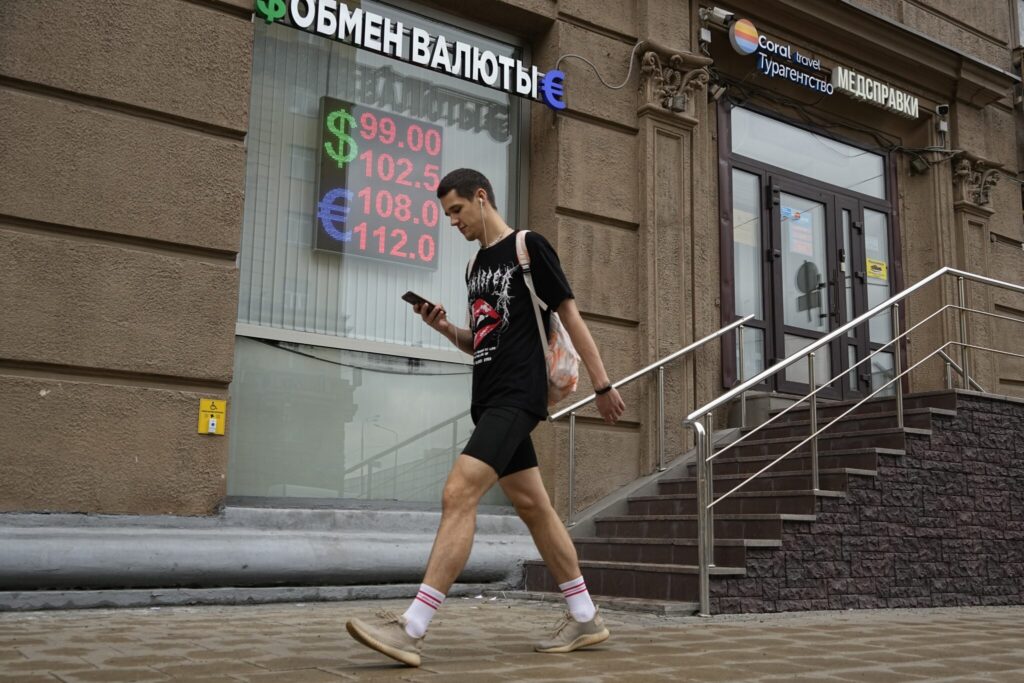
Meanwhile, imports have started to recover after nearly a year and a half of war as Russians find ways around sanctions. Some trade has been rerouted to Asian countries that are not participating in sanctions. And importers have found ways to ship goods through nearby countries such as Armenia, Georgia and Kazakhstan.
At the same time, Russia has ramped up defense spending, pumping money into companies that make weapons, for instance. Companies must import parts and raw materials, while some of the government spending finds its way into the pockets of workers, especially because Russia is facing labor shortages.
That government spending, along with the willingness of India and China to buy Russia oil, is helping the economy perform better than many had expected. The International Monetary Fund said last month that it expects Russia’s economy to grow 1.5% this year.
WHY DID THE CENTRAL BANK RAISE INTEREST RATES?
To fight inflation, first of all. A weaker ruble worsens inflation by making imports more expensive in Russian currency. And the ruble’s weakness is increasingly being passed through to prices people pay.
Inflation hit 7.6% over the past three months, and the central bank’s goal is 4%.
Higher interest rates will make it more expensive to get credit, and that should limit domestic demand for goods — including imports. So the central bank is trying to cool off the domestic economy to lower inflation.
It raised its key interest rate from 8.5% to 12% at an emergency meeting Tuesday after the ruble’s fall was criticized by a Kremlin economic adviser.
DOES THIS MEAN SANCTIONS ARE WORKING?
Yes and no. Exports have fallen because Western allies have boycotted Russian oil and imposed a price cap on those exports to non-Western nations. The sanctions work by preventing insurers or shippers — mainly based in the West — from handling Russian oil above $60 a barrel.
The cap and boycott instituted at the end of last year has forced Russia to sell at a discount and take expensive steps such as obtaining a fleet of ghost tankers that are beyond the reach of sanctions. And Russia cut off most natural gas sales to Europe, its biggest customer.
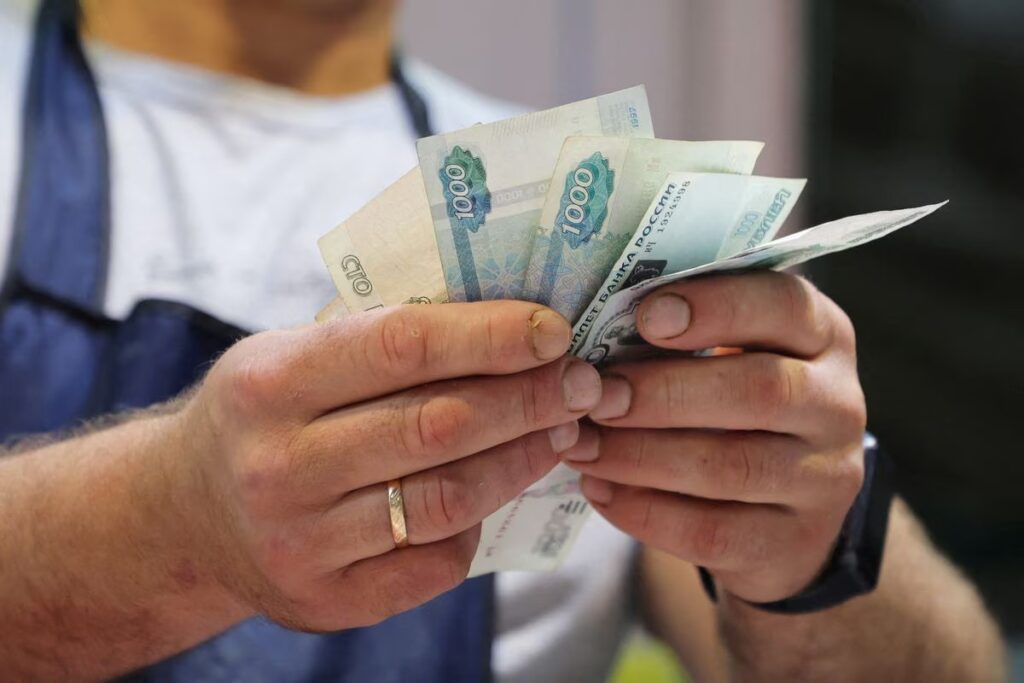
This photograph taken on July 6, 2022 shows a Russian ruble coin in Moscow.
Oil revenue fell 23% in the first half of this year but Russia still earned $425 million a day from oil sales, according to the Kyiv School of Economics.
However, higher oil prices have recently sent Moscow’s supplies above the price cap, the International Energy Agency said in an August report.
The rebound in imports shows that Russia is finding ways around sanctions and boycotts. It’s more expensive and cumbersome, but if someone needs an iPhone or a Western-made car, they can get it.
So the ruble’s fall was caused by sanctions, successful efforts to evade their impact and Russia’s war effort itself.
IS RUSSIA HAVING AN ECONOMIC CRISIS?
No, says Chris Weafer, CEO of Macro Advisory Partners. “The lower ruble is partly a reflection of the effect of sanctions, but it doesn’t indicate an underlying economic crisis.”
The falling ruble actually has helped the government in important ways. A lower exchange rate means more rubles for every dollar of earnings from oil and other products it sells. That bolsters government spending on the military and on social programs aimed at blunting the impact of sanctions on the Russian people.
“What the central bank and the Finance Ministry has done over the last several months, is they’ve tried to compensate for the drop in the dollar value of oil receipts with the weaker ruble, so that therefore the deficit in terms of spending could be contained and more manageable,” Weafer said.
Amid sanctions and restrictions on moving money out of the country, the ruble exchange rate is largely in the hands of the central bank, which can advise major exporters when to exchange their dollar earnings into Russian currency.
When the ruble fell below 100, however, the Kremlin and the central bank drew a line.
“The weakness was planned, but it’s overdone and they want to pull it back,” said Weafer, who foresees the ruble trading in the mid-90s in the coming months, roughly where the government wants it.
WHAT DOES THIS MEAN FOR EVERYDAY RUSSIANS?
Inflation caused by ruble devaluation hits poorer people harder than others because they spend more of their income on necessities such as food.
Foreign travel — enjoyed mostly by a minority in prosperous big cities such as Moscow and St. Petersburg — gets much more expensive with a weaker ruble.
In any case, popular dissent is limited by government restrictions on criticizing the war effort including jail time for those who speak out.
“The instability of the national currency has always not very good impact,” said Dina Solovyova, 51, a veterinarian. “Most likely, this will affect ordinary people, because the rise in prices for everything will surely follow. We’ll wait and see.”
Nikolay Rubtsov, a 20-year-old, indicated he wasn’t much disturbed by the ruble’s fall.
“This is all temporary. I think everything will be back to normal soon. I don’t think it can last long,” Rubtsov said in Moscow.

